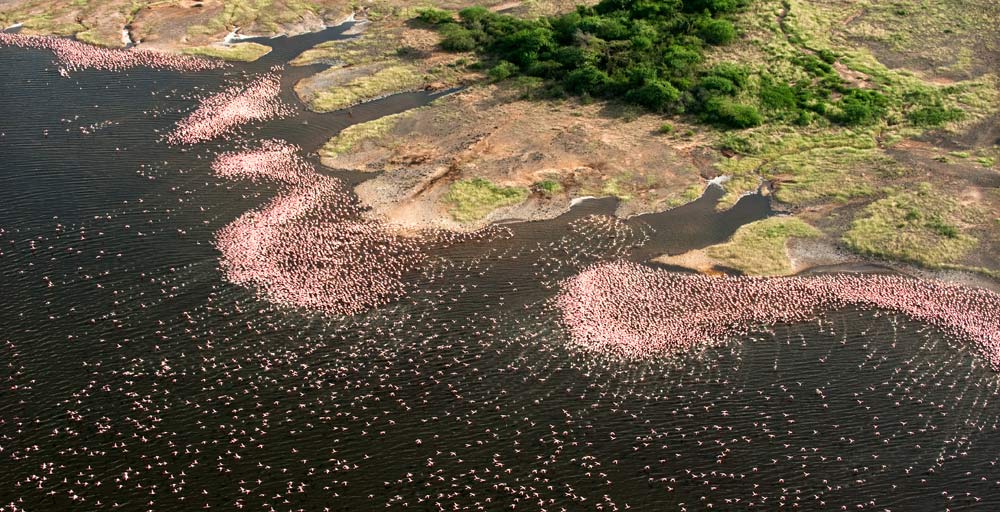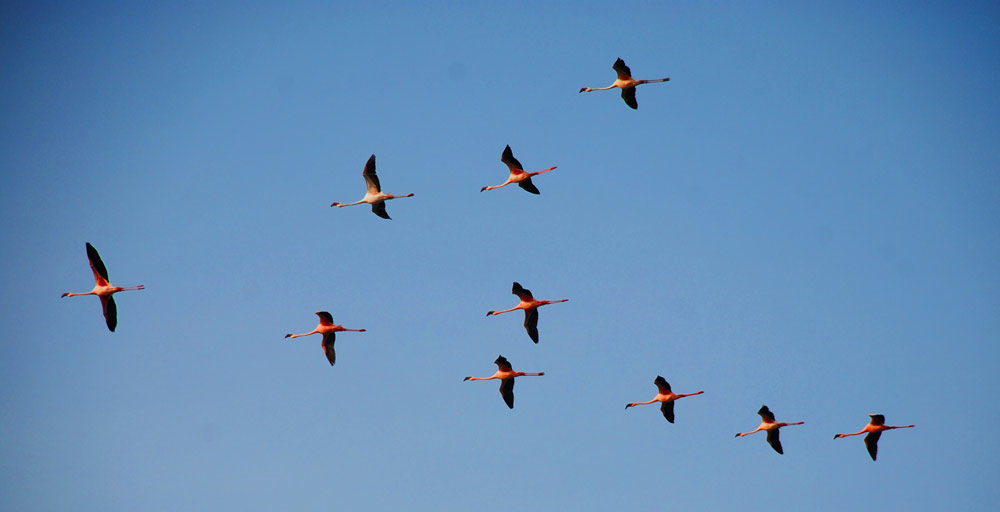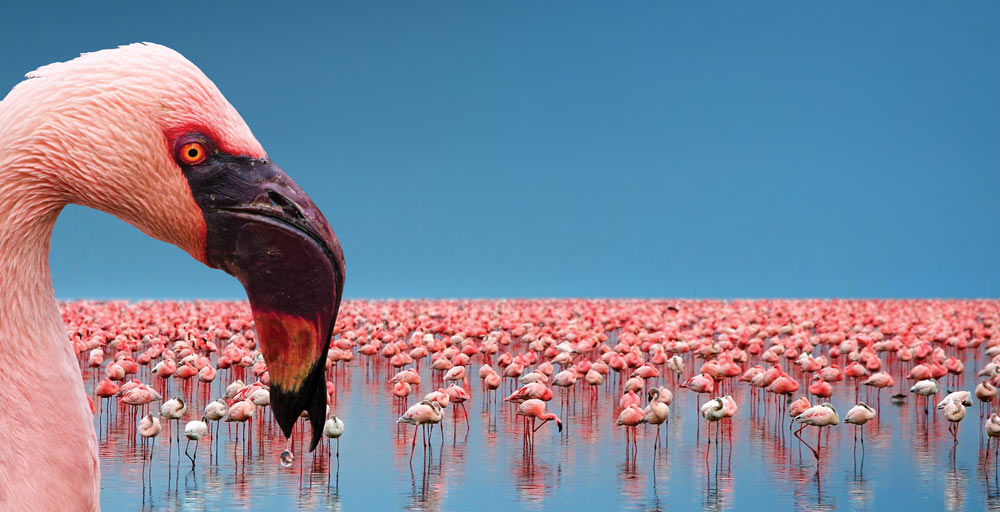Well, actually, they’re not.
Strange but true: flamingos are born grey and their feathers only turn pink as they eat their preferred diet of the blue-green algae, Spirulina, which contains a natural pink dye called canthaxanthin. Consequently, flamingos kept in zoos turn from pink to grey, unless they have synthetic canthaxanthin added to their diets.

The most fabulous bird spectacle on earth
Spirulina has a lot to answer for in the life of the flamingo: a periodic low Spirulina count in the waters of their most famous home on Lake Nakuru causes them to migrate north and south to Kenya’s other lakes. If there’s a high Spirulina count, however, then as many as 1.5 million birds might arrive to create what famous ornithologist Roger Tory Peterson called, ‘the most fabulous bird spectacle on earth’.
The spectacle comes, however, at a price because an average population of 300,000 flamingos suck around 180 tonnes of Spirulina out of the lake every day. That’s a lot of algae. And nor is it always available. Sometimes, after a long dry period, the level of the water in the lake will reduce and its alkalinity will increase. This is bad news for the Spirulina, which cannot tolerate too high an alkaline content. Consequently they shrivel up and die.
This leaves the flamingos with a conundrum: they can deviate from their diet, depart for another lake, or die. It’s a tough choice and, though the flamingos try to survive on an alternative algae known as Clamydomonas, it’s considerably smaller than Spirulina and slips through the filtering system of their beaks. So, faced with starvation, they have only one choice – to migrate.
In search of Spirulina
Migrating flamingos make for one of nature’s most glorious spectacles. Rising from the lake in choreographed flights of coral pink, they head off in V formation, streaking the blue skies pink, and filling the air with the sound of their honking. Where do they go? Any large expanse of water might attract them, but not before they’ve checked it out for Spirulina. And if the menu isn’t up to scratch, they’ll move on. Sometimes south, sometimes as far north as up to Lake Turkana, even to Ethiopia and Botswana.

The lesser flamingo is one of the world’s six flamingo species, but when it comes to eating Spirulina, it’s a master of the art. Custom-built for the job, it has long legs that allow it to wade and feed in water nearly a meter deep, while its long neck allows it to reach down into the water where it feeds with its head upside down.

Flamingos harvest their algae by ‘grazing’ along the top of the water, skimming only a few centimetres of it into their elegantly curved bills. Inside the bill is a complex filtration system. The upper mandible is triangular and fits tightly into the lower bill when closed, and the inner surfaces of both are covered with fine hair arranged in rows of about four to the centimetre. The thick, fleshy tongue fits neatly into a tubular groove in the lower mandible where it moves back and forth like a piston. As the tongue retracts, water is sucked in over the filter hairs; as it extends the water is forced out causing the algae to be caught in the fine filament hairs of the mandibles. Consequently, if you watch a flamingo feeding, you will notice a pulsing ring of water coming rapidly out of its beak.
Did you know?
It’s not only flamingos that thrive on Spirulina – it is also highly beneficial to humans – being rich in protein and a good source of antioxidants, B-vitamins, iron and calcium. Indeed so nutrient-packed is Spirulina that it has been dubbed ‘the most nutrient-dense food on the planet’. The good news is, however, that it doesn’t turn humans pink.
Flamingo Facts
Greater Flamingo (Phoenicopterus roseus)
Identification: 56 in / 142 cm. Plumage white with a pink wash, wing-coverts and auxillaries bright coral-red; flight feathers black, bill pink with black tip – a much larger and paler bird than the lesser flamingo, easily recognised by its pink bill and ‘S’-shaped neck.
Lesser Flamingo (Pheonicopterus minor)
Identification: 40 in / 101 cm. Plumage deep pink, much darker and brighter than the greater flamingo; bill dark carmine-red with black tip.
© 2025 Kenya Holidays
